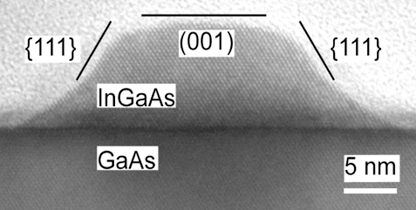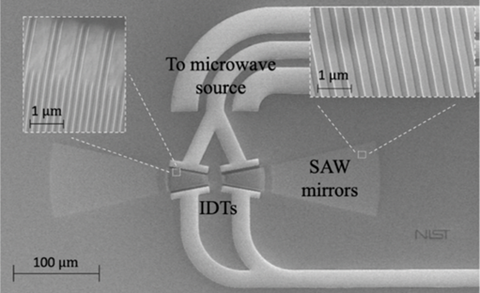Summary
Fully optimized and functional quantum machines will be hybrid systems that combine disparate quantum systems into a single device exploiting the best attributes of each. For instance, a large-scale network of superconducting quantum computers will require a transducer to convert fragile microwave quantum states into optical photons that act as flying qubits. Our project, along with the Advanced Microwave Photonics project, aims to fabricate and explore the physics of hybrid systems composed of microwave photons, gigahertz frequency phonons, and solid-state optical single-photon emitters. Combining and linking all three system on a single micro-chip, while maintaining state-of-the art performance of the individual components, is a difficult and exciting challenge requiring careful design and full use of NIST’s world class nanofabrication facilities.
Description
Quantum Dot – Surface Acoustic Wave Microwave-to-Optical Transducers
In this project, we focus on coupling nanoscale acoustic resonators with InAs quantum dot (QD) single photon sources (Fig. 1). At ultra-low temperatures, such as those in a dilution refrigerator, the acoustic resonators act as simple quantum harmonic oscillators and can exchange a single quantum of sound (phonon) to a visible light photon via the embedded QD. A device based on this technology could be used as a quantum communication module that links multiple superconducting quantum computers over a kilometer-scale optical fiber network. We have fabricated first generation devices (Fig. 2) that prove the viability of this approach, and we are aggressively pursuing improvements to reach quantum-compatible performance.


High Performance, Deterministic, Single Photon Sources
A truly deterministic single-photon source would be a disruptive technology in the fields of quantum communications and optical quantum computing. The closest system to achieving the required performance is based on optically-active, epitaxial semiconductor quantum dots. They feature gigahertz emission rates, high brightness, and excellent fidelities. We are currently fabricating sources with the aim to install them in the future Boulder Area Quantum Network. In addition, we are exploring the use of hybrid technology to trigger single photons with single confined acoustic phonons. This should increase collection efficiencies, reduce background pump noise, and reduce the probability of generating 2 photons instead of the required single photon.

